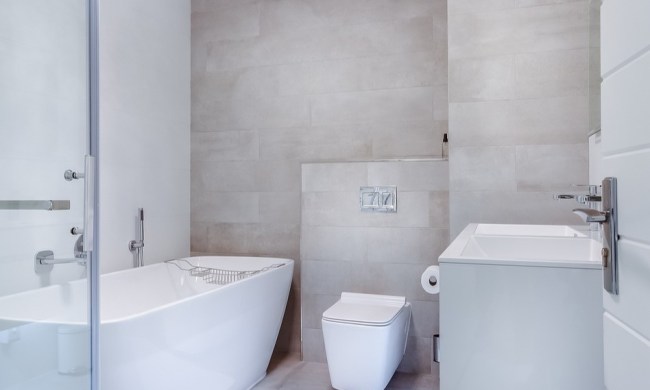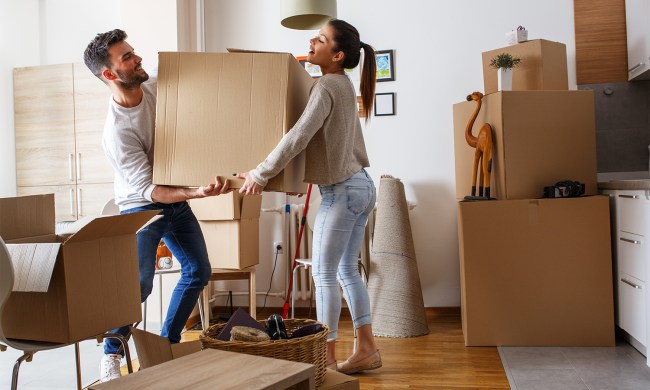The mudroom. A transition place between outdoors and indoors, a spot for keeping your family’s clutter and mess in one central location, and often the first room your family enters in your home. But, sometimes, a mudroom ends up being a catch-all for clutter—where shoes and sports equipment fight for space with coats, umbrellas, and backpacks. Sadly, a disorganized mudroom is more than just unsightly; it can also cost you—in time, aggravation, and even money (hello, misplaced baseball cleats)! But it doesn’t need to be that way.
With proper planning and the addition of some simple mudroom shelves and storage ideas, you can transform your space into a clutter-free oasis of organization. Here are some storage solutions for your mudroom – hopefully, these will allow you to take control of this area in no time at all!
 Start with a clean slate
Start with a clean slate
Before you begin organizing, you’ll need to start fresh. Remove everything from your mudroom and find a “dumpling spot” to put it all—in the garage, basement, or backyard (weather permitting). Now that everything’s in one spot, it’s time to start sorting.
Pair up mittens, gloves, snow boots, and shoes and toss anything that doesn’t have a match or has been outgrown by everyone in the family. Take inventory of your sports equipment and donate what isn’t being used anymore. Once you’ve decided what you’re keeping, make sure to clean everything before it goes back into the house.
Now that the mudroom is empty, it’s the perfect time to give it a thorough cleaning. Walls, floors, and windows should be vacuumed, swept, and washed until they are sparkling clean. While everything is out of the room, why not give it a fresh coat of paint? Let the room itself help decide on the color. If the room is well lit with lots of sunny windows, you can go with a bolder color; but if the room tends to be dark, keep the paint color light.
 Mudroom shelves make all the difference
Mudroom shelves make all the difference
Does your mudroom have built-in shelving or benches? Congratulations, you’re already ahead of the game. All you’ll need to do is spruce them up with some fresh paint and maybe even some new bench cushions to give the room a whole new look.
If, however, your room isn’t pre-equipped with mudroom shelves, you definitely should make them a part of your new and improved mudroom. After all, keeping things off the floors is how to keep your mudroom neat and tidy for years to come.
There are plenty of ready-made mudroom shelves you can find online or at your local home supply store, and look for storage solution benches that provide seating for putting boots on and off with storage cubbies beneath to keep footwear neat and tidy. Look for pieces that not only work with the dimensions of your room, but also the needs of your family.
When putting items on your newly-installed shelves, let practicality and ease of use guide you. Separate seasonal items and place out-of-season items in storage bins or shelving that’s higher up, leaving the current season’s items within easy reach—no need for snow boots in July or baseball mitts in January!
 More mudroom storage ideas
More mudroom storage ideas
- Make “less is more” the new mantra for your new mudroom. Remember, just because something was in your former mudroom doesn’t mean it needs to be in your new-and-improved mudroom.
- Try instituting a maximum item count rule for each member of your household. Give each person space for two or three pairs of shoes, one backpack or purse, and one coat. They should store the rest of their overflow items in other closets or storage spaces in the house.
- Build your own mudroom organization system by turning stackable wooden cubes into customized furnishings, giving instant cubby storage for all of your family’s essentials.
- Designate a cube or storage container for each family member to help save time searching for lost shoes in the morning scramble.
- Add a stand for holding umbrellas, a designated bin for sports equipment and balls, baskets for mittens, hats, and scarves, and other containers for the items that you and your family need regularly.
- Install hooks on walls for baseball caps, backpacks, jackets, and smaller hooks to hold keys. The trick is to keep as much as possible off floors and have a designated spot for absolutely everything.
- Utilize bins, baskets, and containers to keep floors free of clutter. Coats and jackets should go on hooks. Mittens and gloves should stay as pairs with clothespins (or by folding the wristbands inside out together). Do everything you can to maximize organization and save time.
It’s easy for your mudroom to descend into chaos, but we’ve shown you how easy it can be to restore organization and sanity to even the smallest mudroom space. The trick is to purge what you’re not using and keep only the items you and your family need regularly. Do seasonal refreshes by moving out of season items to other storage areas. If you stick to your organization plan and take advantage of the new storage items you’ve made or purchased to keep clutter at bay, you’ll be able to stay organized not just today but every single day.
 Start with a clean slate
Start with a clean slate Mudroom shelves make all the difference
Mudroom shelves make all the difference More mudroom storage ideas
More mudroom storage ideas


